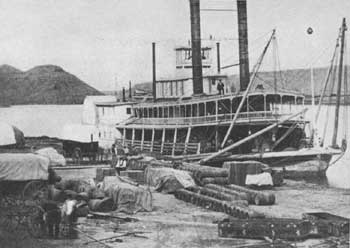






Survey of Historic Sites and Buildings
 |
FORT BENTON Montana |
 |
| ||
Ownership and Administration. Various.
Significance. Fort Benton, an important post on the Missouri River during the late fur trade era, was also the hub of traffic from the East to the goldfields of Idaho, Montana, and Canada. At the head of steamboat navigation on the Missouri, it was the eastern terminus of the Mullan Road, which ran westward to Fort Walla Walla. Established in 1847 by Alexander Culbertson as Fort Lewis, it became known in 1850 as Fort Benton and was soon the most important fur trading establishment in Montana. It was a military post from 1869 to 1875.
After the arrival of the first steamboat, the Chippewa, in 1859, a new era began. A town grew up around the fort, and steamboats arrived regularly. After the Montana gold strike in 1862, miners rushed to the town by steamboat and then traveled overland to Bannack, Virginia City, and other mining camps that were located in the interior. Ox teams and pack trains carried food, clothing, ammunition, and whisky from Fort Benton to Idaho, Montana, and Canada. Much of this traffic passed westward over the Mullan Road, opened in 1863 as a military road from Fort Walla Walla. The Mullan Road was also used by emigrants en route to the Northwest and gold seekers traveling to Idaho and Montana. By the middle 1860's its importance increased as keen competition developed between St. Louis, Mo., and Portland, Oreg., for trade with Montana settlements. From each of these cities cargo was shipped to the termini towns on the Mullan Road, from which mule pack trains carried cargo into the mountains.
 |
| Steamboat discharges freight at Fort Benton, head of navigation on the Missouri River, in the 1860's. Courtesy, Montana Historical Society. |
In 1868 downriver shipments from Fort Benton totaled $1,200,000, and inbound shipments $1,394,000. When the railroads arrived in the region, the river traffic declined and the town lost its importance as a shipping center.
Present Appearance. All that remains today of the early fort itself are a blockhouse and a portion of the adobe walls. The riverfront, along which the steamboats once docked and unloaded their cargoes, is little changed. Several brick and stone commercial buildings of 19th-century vintage give a historic flavor to the town. [19]
NHL Designation: 11/05/61
 |
 |
http://www.cr.nps.gov/history/online_books/prospector-cowhand-sodbuster/siteb10.htm
Last Updated: 22-May-2005